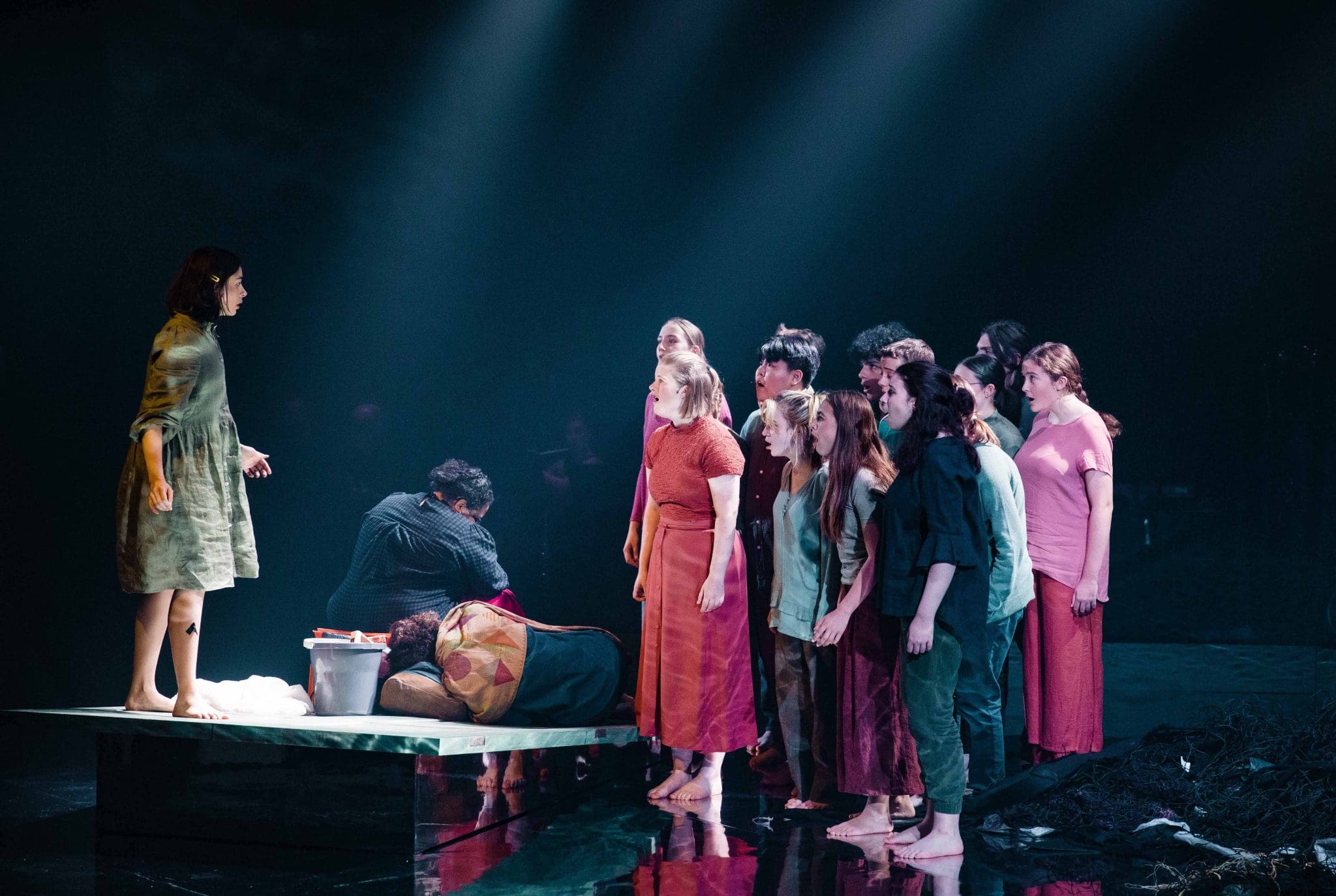At the heart of UnWrapped’s original chamber opera Three Marys lies the concept of the abject, represented by three central characters who are exiled from civilization and lie just beyond the sphere of representation. Three Marys points the spotlight squarely at those lost “others”, especially the female victims of male culture and the dejected bodies of refugee children. By bringing them into the daylight of imagination, it asks us not to forget their names, to honour their memories, and to endure in the face of domination.
As a consequence, Three Marys is a bold new opera, and one that develops a sophisticated new outlook for the medium. It is often also a chimerical and gestural beast, difficult to pin down and determined to weave its biblical heritage with the torment of contemporary immigration politics. Its score, composed by Andrée Greenwell and performed live by an orchestra, is similarly diverse, utilising more traditional swelling strings, plucked chords, classical guitar, and sharp dissonant rings that unsettle just as much as they delight.
The libretto of the work, composed by Christine Evans, follows the mediaeval myth of three condemned women, all of whom share a name, torn out of their homes after the Crucifixion for their association with Jesus Christ. These women, played by Samantha Hargreaves, Jessica O’Donoghue and Heru Pinkasova are cast out to sea, huddled together on a boat and uncertain if they will live to be rescued or join the chorus of the drowned.
From the outset, it seems that the showrunners wish to grant these condemned women some veneer of divinity, likely suggesting that even the downtrodden and outcast amongst us reflect the beauty of godliness. As much is revealed to us through the symbolic costuming of Maria, portrayed by Heru Pinkasova, shrouded in a shawl that both blocks her from the sun and recalls La Pieta.
But, in keeping with the work’s subversive and at times contradictory bent, the true story is not as simple as that of a tormented holy woman, Maria. In a stunningly engaging reclamation of agency, she voices an early number that breaks entirely with her association with immaculate conception. Rather than free from carnal sin, Maria is embodied as a woman forced to eschew the truth of her own desires and rejected for expressing the reality of her humanity.
This is the first appearance of a central tension in the work between humanity and divinity. It is further represented through the invocation of objects, as the characters list their remaining worldly possessions. The emphasis on their menstrual products highlights that though regarded as divine, these women are human and have suffered the paradigmatic pains of womanhood.
But it is through the introduction of the character Marzoug, played with gusto by Eddie Muliaumaseali’i, that the use of objects in the work begins to truly blossom. Marzoug is a figure who wanders the beaches of his hometown, collecting the bodies of refugees that wash up and burying them in nameless graves. In the work’s most touching moment, he reveals to us that he buries the drowned children with toys, as a way of providing them individuality and the dignity of play.
It is not merely through objects that we come face to face with the humanity of the refugee crisis, but also through the use of a youth chorus, sourced from NSW Public School’s Arts Unit. This group portrays the lost souls of drowned children from around the world. Voiced in English, French, and Arabic, they give a corporeality to those whom many of us, especially in a nation wedded to its inhumane policies on refugees, would rather look away from. Featured vocalist Charbel Moussa’s unaccompanied solo performance in Arabic is likely to particularly remain with audiences.
However, what hampers the emotional resonance of the work as it enters its last act is not the quality of the performances, but the staging. With the titular characters trapped on a boat, represented by a plank on a silver plinth in the centre of the stage, much of the work was necessarily static. Though the chorus of young people had the only potential liberty of movement, they too were hampered by the placement of a giant column of ocean rubbish suspended from the ceiling. This feature, though clearly linked to the concept of the abject, functioned confusingly in the space, making the domain of the drowned, above the surface rather than underneath. The result was that there were very few opportunities in the work for dynamic movement. This was certainly missing, as it would have invested the tempestuous sea with enough tension to allow us to buy into the life and death struggle faced by the characters.
Ultimately though, at the resolution of Three Marys, I was struck by the success of many of the risks that the production had taken, especially within a form deep in tradition and often regarded by young people as staid. Serious though this production may have been, dreary it was not and that fact, along with the sophistication of its themes, earns it a rightful place in Australian opera.
Three Marys played at the Sydney Opera House, as part of the UnWrapped Festival, from the 11th-13th of May.





